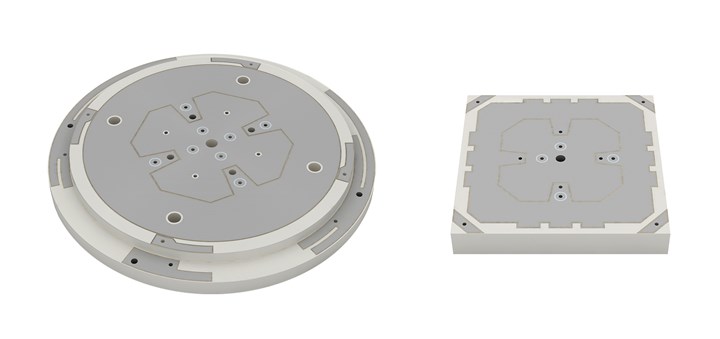Engineered Compounds for Auto Global Navigation Satellite System Antennas
SABIC’s newest additions to the LNP Thermocomp family of compounds offer the potential to improve signal gain performance vs. ceramics in second-generation automotive GNSS antennas.
The two latest additions to the LNP Thermocomp family of engineering thermoplastic compounds from SABIC reportedly offer the potential to improve signal gain performance vs. ceramics in second-generation automotive global navigation satellite system (GNSS) antennas. The new products, LNP Thermocomp ZKC0CXXD and ZKC0DXXD compounds have been shown to help enable the design and molding of antenna substrates with more-complex pattern markings that add effective surface area, a critical factor in enhancing signal capture.

According to SABIC, for customers that currently use ceramics, switching to the LNP Thermocomp compounds can help lower system costs by avoiding secondary operations, as well as improving antenna performance. Designers and engineers who find incumbent materials inadequate for developing novel, high-resolution GNSS antennas can help address new requirements with these products. The antenna serves as the front end of the GNSS signal processing chain. Optimal signal gain requires maximum surface area to capture radio signals from satellites.
Second-generation GNSS antennas operate by combining signals from satellites with two different frequencies for high resolution, making signal capture even more demanding. To expand the effective surface area of the antenna substrate, manufacturers create complex pattern markings. However, ceramic materials are restricted in the shape and complexity of patterns that can be used because of challenges in applying metal plating to small or constrained spaces. These factors can affect antenna performance and limit the suitability of ceramics for high-resolution GNSS systems.
In contrast, SABIC’s new LNP Thermocomp compounds can be easily injection molded into antenna substrates with a wide range of pattern markings. Intricate shapes, indentations and other elements can significantly increase an existing part’s effective surface area, supporting the stringent signal gain requirements of high-resolution GNSS antennas. In addition to helping manufacturers achieve superior signal gain compared to ceramic substrates, the new compounds also boast flexibility for the production of smaller parts with the same performance as ceramic, or equal-size parts with better performance. They offer a high dielectric constant (Dk) for miniaturization and a low dissipation factor (Df) to facilitate signal acquisition, can be tailored to meet the electrical requirements of individual applications. They feature electroplating capability, good thermal resistance for reliability, and the design freedom and production efficiency of thermoplastics. Both are well-suited for shark fin-style and new conformal antenna designs.
The new SABIC materials also help to reduce system costs compared to ceramic substrates, which require time-consuming secondary operations such as shaping, drilling and polishing. Injection molding with LNP Thermocomp compounds can deliver higher throughput and productivity and reduce scrap to keep costs down. Thermocomp compounds based on high temperature resins enhance properties even in demanding high heat and chemical environments. They are available in more than 25 different base resins, including Ultem PEI, PEEK, various nylons, PPS, and melt processible fluoropolymers. A number of reinforcing additives are used in Thermocomp compounds, including glass fiber, carbon fiber, glass beads and various minerals, and all can be compounded for flame retardancy, and in a wide range of opaque colors.
Related Content
-
Tracing the History of Polymeric Materials: Polyphenylene Oxide
Behind the scenes of the discovery of PPO.
-
Tracing the History of Polymeric Materials: Acetal
The road from discovery in the lab to commercial viability can be long, and this was certainly the case for acetal polymers.
-
Volume Resin Prices Move in Different Directions
PE, PP, PVC, and ABS prices slump, while PS, PET, PC, and nylons 6 and 66 prices rise.












 (2).jpg;maxWidth=300;quality=90)


